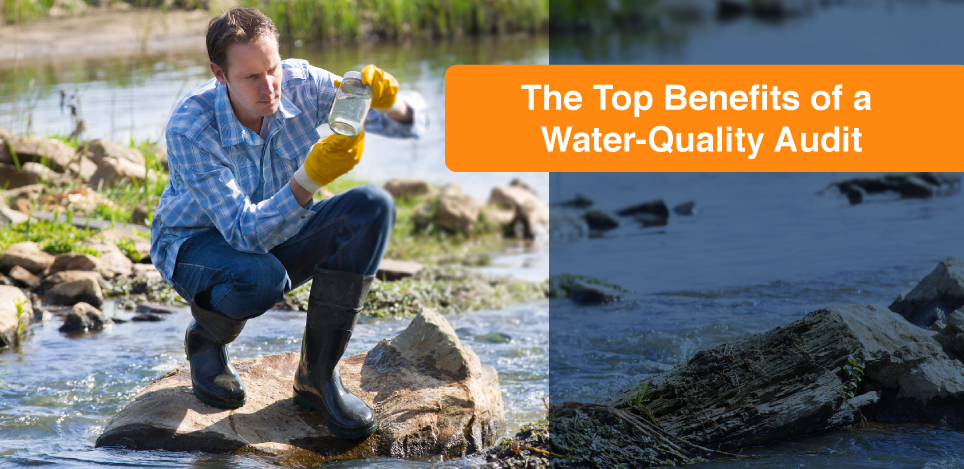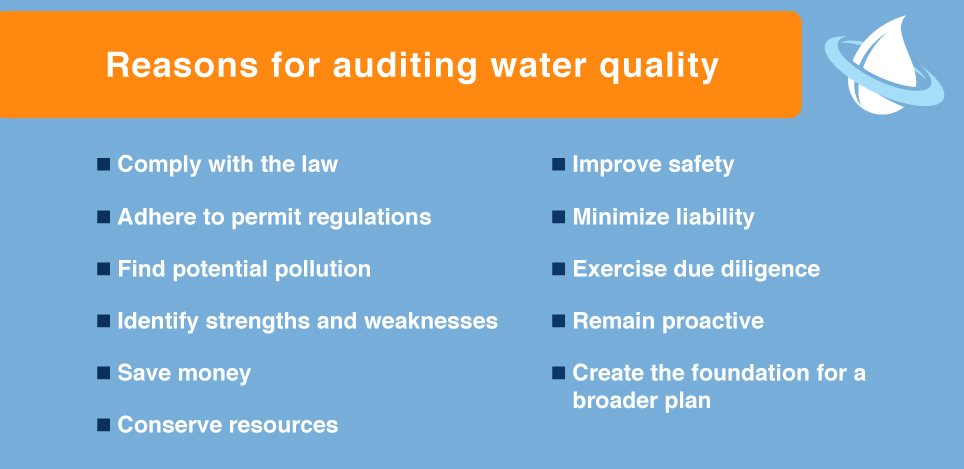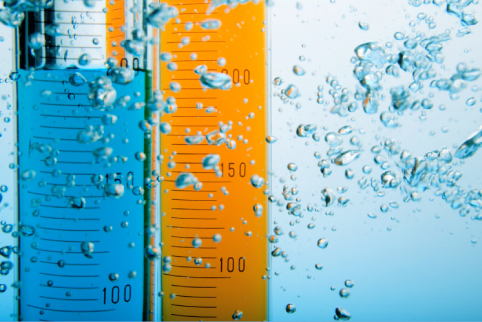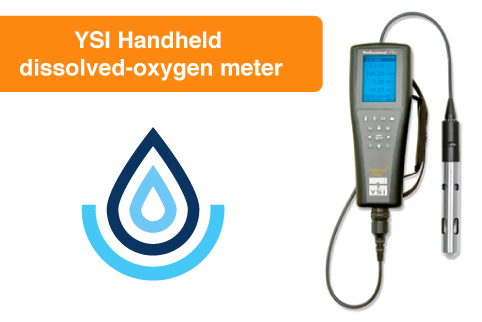The Top Benefits of a Water-Quality Audit

You can hardly overstate the importance of water, one of the basic elements and rightly known as the universal solvent. It falls down from the sky and bubbles up from the earth to nourish humans, animals and plant life.
Water comprises 66 percent of the human body, which can’t go without it for more than about three days. Water covers 71 percent of the Earth, where it quenches thirst, provides food, washes things clean and keeps crops and animals alive. Water is so important that scientists seek evidence of it on other planets.
Beyond its most essential functions, it gives us endless options to please our palettes with caffeinated drinks or cocktails and to swim, fish, ski, boat, float and paddle for entertainment and recreation. Real estate pros know water mesmerizes people and soundly advise buyers to invest in property by water.
We watch the river in our neighborhood, never calling to mind the bigger picture of flowing rivers everywhere feeding one another and eventually running into the oceans. Water flows from and into seas, lakes, rivers, streams and creeks as well as ponds, watersheds, the ground, springs and mountains.
Each person might perceive water differently but everyone agrees it is important. A lot of people would like to acquire water wisdom but don’t have time to earn a degree in hydrology and fear that seeking answers from a professional will bust their budget. However, anyone can increase their water wisdom with an audit and the right tools.
Why Audit?

You might think it sounds like too much hassle or too official for what you want, but audit literally means a careful check or review of something. So in this context, you decide exactly how careful or in depth the check will be.
Audits educate and automatically count as proactive. You might pick up on something during your analysis that leads to prevention of a future problem or to an important discovery that would otherwise go unnoticed. Doing a casual audit on your own dime and time also beats nasty surprises that may arise when an undiscovered issue reaches a critical point.
In some cases, companies are required to do an overall environmental audit that includes water quality and monitoring, but by law or not, water wisdom stands to save businesses major costs, time and potential headaches. An adverse situation can damage image, morale and financial status, as well as create thorny situations with the Environmental Protection Agency.
There are many reasons for auditing water quality:
- Comply with the law
- Adhere to permit regulations
- Find potential pollution
- Identify strengths and weaknesses
- Save money
- Conserve resources
- Improve safety
- Minimize liability
- Exercise due diligence
- Remain proactive
- Create the foundation for a broader plan
A lot of businesses try for official recognition through the International Organization for Standardization, which gives guidelines for best practices and management systems. More and more, achieving ISO’s 14001 certification represents a high international standard and mark of good environmental stewardship. While the process is not a simple one, the ISO standards basically encourage people to plan, do, check and act.
ISO-level standards may be beyond the goals of an average homeowner, a river-protection group, a lake association or a garage scientist, but those people also have plenty of options to increase their water wisdom by looking at the past, auditing the present and monitoring in the future.
How to Audit
While a land developer exercising due diligence will conduct his audit differently than the hobby fisherman who owns a riverfront home, both want more information and in essence conduct some kind of audit. Generally, two things motivate someone to audit or monitor water quality: regulatory compliance and general concern or curiosity.
People who decide to conduct an audit should decide whether they will do it themselves or hire a scientist. The first option can be interesting but also time-consuming, and the second option nearly always costs money and may include elements you’re not interested to analyze.
Companies do best in assembling a team for audits with representatives from each department representing different perspectives. Individuals can grab audit partners from among family members, neighbors, friends or environmental advocates. The team prepares for the three stages of an audit:
- Pre
- Process
- Post
While every audit is different, most follow these general steps:
- Determine an objective
- Define the scope
- Gather data
- Monitor the subject
- Report results
- Implement action
The team decides exactly what activities the audit will include, but generally this includes reviewing current policies, visiting and walking the site, looking at operations, talking to people and gathering information according to a schedule. For water quality, you’d check for information at the federal, state and local levels of government, as well as with land trusts, lake or wildlife associations, farm bureaus and other natural-resource organizations that might have information relevant to your plan and scope.
Gathering data could include getting aerial photos both modern and historical, examining water records, collecting samples and metering or testing. For professional and do-it-yourself auditors, Envisupply offers a broad selection of testing and safety equipment to rent or sell. For example, water-quality meters range in cost from $100 to thousands of dollars.
Contents Prove Complex
 Water seems to have a simple chemistry, yet few other than water-science specialists understand its complexity. As people worry about its health and quality, it increases your water wisdom to have a basic understanding of water’s content and properties.
Water seems to have a simple chemistry, yet few other than water-science specialists understand its complexity. As people worry about its health and quality, it increases your water wisdom to have a basic understanding of water’s content and properties.
Conductivity measures how able the water is to pass an electrical current and can be affected by such dissolved solids as negatively charged chloride, nitrate, sulfate, phosphate, positively charged magnesium, calcium, iron and aluminums. Water carrying more minerals tends to be warmer.
Dissolved oxygen matters because the less oxygen, the higher the temperature and the more at risk aquatic life may be. Temperatures in winter and spring are typically lower, and the water has more dissolved oxygen, but it’s the opposite during spring and summer. The EPA shows optimal temperatures for fish and the ranges at which they’ll survive as juveniles and be able to spawn. For example, prized brook trout need a max temperature of 55 degrees Fahrenheit to spawn and no more than 66 degrees Fahrenheit for juveniles to survive. Channel catfish have their limits, too: at 84 and 90 degrees, respectively.
Pure water has a neutral pH of seven, which is neither acidic nor basic. The U.S. Geological Survey says pH tells the amount of free hydrogen and hydroxyl ions in the water, which more simply put is how acidic it is. The scale runs from 0-14, with battery acid at one and lye at 13. A dip to or below 4.5 can affect fish reproduction or kill them.
Temperature impacts all biological activity in water and is crucial to aquatic life. If an organism’s optimal temperature range does not exist, it does not survive. Monitoring water temperature tells a lot about its health. For example, if a flowing river keeps getting warmer, it could be from too much storm water running off of rooftops and other impervious surfaces, which interferes with the water’s naturally balanced temperature.
Turbidity is a measure of water clarity and basically tells you how much stuff is in there. Clay, silt, fine materials, algae, plankton and microscopic organisms can cause water to appear cloudy or brown. Most water-treatment processes effectively cure turbidity, but many folks become curious about their favorite swimming beach, fishing spot or other recreational body of water. Too much stuff in the water can ruin the fun and give harmful bacteria a place to live.
Calcium and magnesium dissolve into all water and can leave harsh deposits that ruin or damage water appliances and cause an unsightly, unwanted haze on fixtures, dishes and silverware. These two minerals are measured to determine water hardness.
Chlorine disinfects the water supply, but high pH can depress its effectiveness, so if your area has water with high pH content, it is likely the water also contains more chlorine than a place that doesn’t have high pH content. One of YSI’s products is a handheld chlorinator that measures the chlorine in any water and gives 5,000 tests on four AA batteries.
Chloride is essentially chlorine and salt. It can affect taste at levels of about 250/mg per liter and is not usually considered a health threat, or at least “chloride toxicity has not been observed in humans,” according to the World Health Organization.
Nitrogen and phosphorous come from acid rain, farm fields or livestock manure and can lead to a lack of oxygen in the water known as hypoxic conditions. While both are needed for strong growth, an excess of them has an adverse impact on waters.
Beyond the conditions for which tests are most commonly conducted, people want to measure the iron content or detect sulfur in the water. They may be concerned about drinking-water quality or the condition of the entire watershed. They can find just about any water wisdom they seek through Envisupply and the YSI instruments it has to measure or monitor water quality, depth, content and other aspects.
Audits and Products Deliver Data
Anyone looking to analyze water quality will note a correlation between what’s in the water and the products offered to test it. They’ll be surprised how easy it is to use a variety of YSI meters to measure nearly anything:
- Temperature
- Oxygen
- pH
- Dissolved oxygen
- Water quality
- Turbidity
- Conductivity
- Depth
- Algae
- Salinity
For example, the YSI handheld dissolved-oxygen meter runs on alkaline-style, C-cell batteries. YSI instruments include a multiprobe capable of checking four aspects of water quality simultaneously. The YSI professional meter plus has attachments to measure other things, as well as filters any user can replace.
The YSI depth meter weighs about a pound and goes into the water on a fishing pole. First-time users of a depth meter testified to the results it delivered during a harbor study in Mexico. The water body had difficult dynamics, but researchers discovered by using the depth meter that the harbor has unique temperature-gradient characteristics that could not be detected from the surface.
Envisupply also carries such things as deep or shallow pumps for well sampling and monitoring equipment that can detect leaks or problems and identify ways to be more efficient. The crucial nature of water applies to every living thing and involves big industries and small companies alike.
Maintaining a healthy water supply remains crucial not only for basic survival but also for many ways of life. From those responsible for the water supply and its regulation to the recreational swimmers and residential water consumers, everybody has an interest and a stake in quality water.
Deeper Wisdom Waits
Countless numbers of entities offer information and/or products to deepen your water wisdom:
- Water departments
- Land trusts
- Watershed-management organizations
- River-protection associations
- County and state government offices
- EPA
- USGS
- Environmental Equipment and Supply
- YSI
- Private consultants
- Academic scientists
Incentives exist for good stewardship practices such as river-cleanup days, outreach and education, pervious landscape surfaces, rooftop-runoff catchers and rain barrels. The EPA offers a list of things to do for healthy water, and USGS provides water facts, a groundwater quiz and many other resources. They all speak loudly to water quality and present a lot of opportunities to recognize its importance and increase our water wisdom.
Audit results and other research provide a valuable benchmark of where things stand and give a deeper understanding of water and its interrelationship with just about everything and everyone. Seeking knowledge may also lead to needed correction or enhanced protection and help avoid any unpleasant surprises, or worse, business-breaking problems. The reasons for interest in water and the levels of it vary wildly, but common threads pop out, especially quality, conservation, education and monitoring.
A doting mother wants to give her family the best-quality consumables she can while the chemical-industry executive knows that success depends upon regulatory compliance. A floral or car-wash business may take a refined interest in the water supply while the retiree just wants to know why the tap supply smells. Fishing enthusiasts hold great concern about how their favorite catch fares in local and regional waters, while swimmers want clear, clean refreshing water at their favorite beach.
Whatever their level of interest may be, people have many options from a comprehensive environmental audit that results in a long-term plan or overall management system to a smaller-scale effort that zeroes in on a specific water concern. Everyone has the capacity to become water wise and with knowledge and assistance from the right resources, it’s easier to achieve than most people think.
